



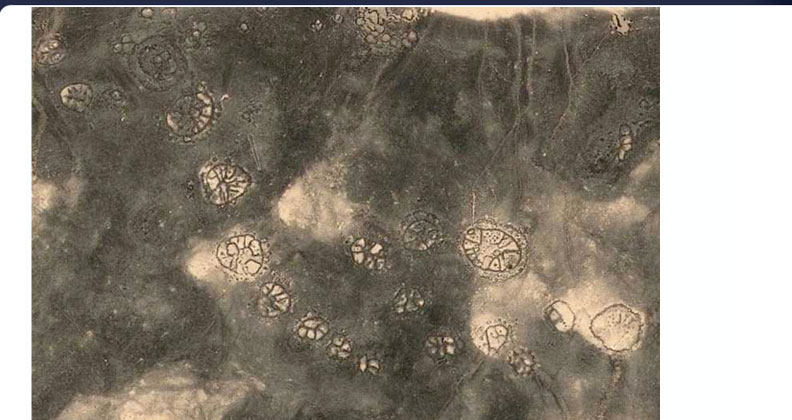
Piezoelectric Stones Form Ancient Circular Structures in the Middle East
Mysterious, Ancient Stone Circles in Middle East Visible Only from Air
by Linda Mounton Howe for Earthfiles.com
September 16, 2011
Syria, Jordan, Saudi Arabia - Scientists at the University of Western Australia have taken almost 45,000 aerial images of mysterious stone circles, or "wheels," they have found by satellite-mapping technologies in Syria and Saudi Arabia and an aerial photography project in Jordan. The number of stone patterns in only the region of Harrat ash-Shaam of Jordan are 1,000 or more.
In an upcoming issue of the Journal of Archaeological Science, David Kennedy, Ph.D., Professor of Classics and Ancient History at the University of Western Australia in Crawley, and his colleague, Robert Bewley, Ph.D., report their discovery of Plains of Nazca-type surface patterns in stone often found on lava rocks at sizes ranging from 82 feet to 230 feet across (25 to 70 meters). The archaeologists refer to them as "wheels" because the patterns are generally circular, often with spokes radiating from a center.
Professor Kennedy has never visited Saudi Arabia, but scanned 1,240 square kilometers of the desert landscape using Google Earth and found 1,977 potential archaeological sites. Then Prof. Kennedy was able to confirm that two of his sites were legitimately archaeological after he asked a Saudi Arabian friend to drive out to the sites and photograph them. He believes they could be as old as 9000 years and certainly at least 2,000-years-old.
He oversees a long-term research project called Aerial Photographic Archive for Archaeology in the Middle East (APAAME ) to develop a methodology for continuing to explore the Middle East by satellite-imaging and Google maps.
The circular structure of lines radiating from a central point like spokes go out to "wheel" edges that are so low that none of the patterns can be seen from flat ground - only from the air.
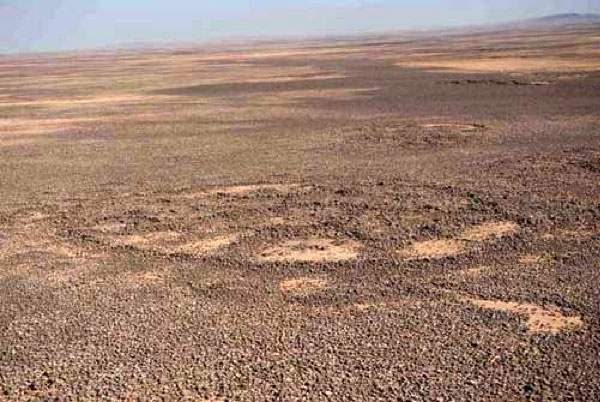
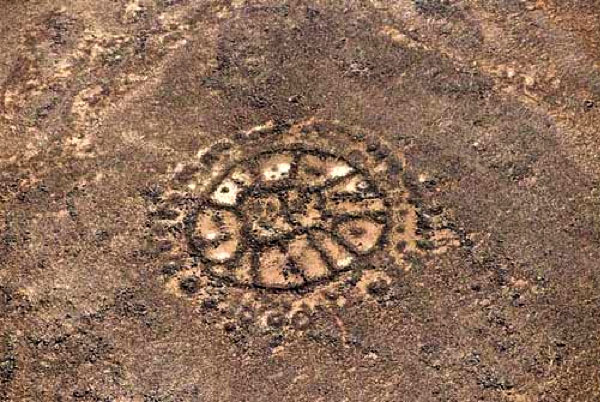
Karen Henderson, APAAME: "The walls are very low on the Wheels, and are built without mortar or shaping of the stone. Although they are well known from aerial photographs and satellite imagery, the structures themselves can be easily missed in the landscape. When surveying Wheels on the ground, they are so ephemeral as to go unnoticed if one does not already know they are there. The above photograph shows the very slightly raised and darker rocks of a Wheel in the Aritein area, demonstrating how hard they can be to see on the ground.
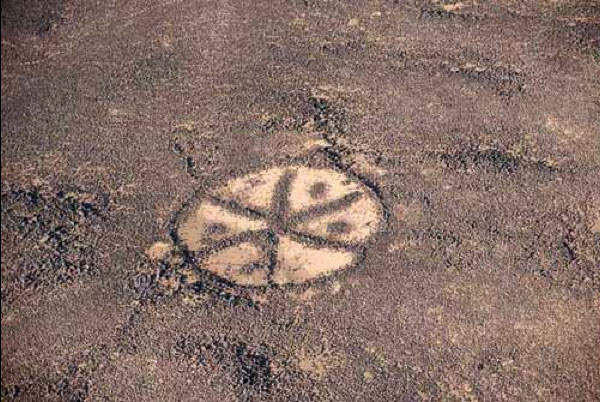
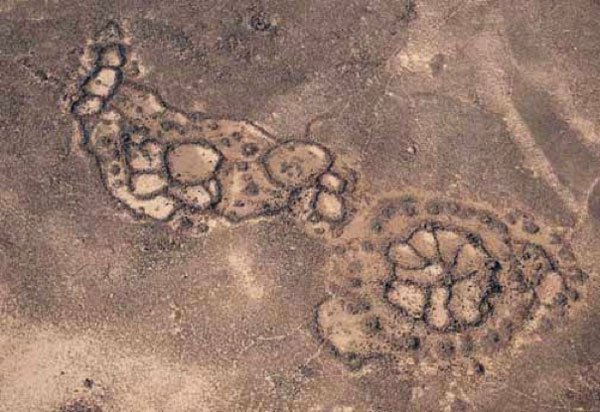
Wheels have large variations in size and type, but they seem to be almost entirely confined to the Harrat ash-Shaam. The only possible example found just outside of the basalt cover in the north of the panhandle is extremely faint and hard to identify. Despite its faintness, the structure appears to be of a common form - a large central open hub with straight spokes, and possibly an exterior wall or ring of Cairns around the outside. The mud pan that it sits on makes it very difficult to see, and it is possible there are other examples in the limestone steppe east and west of the basalt that have not been positively identified as yet...
A Wheel typology (above) has been constructed for the basalt area of Jordan based on several defining features: the type or absence of a central hub; number and straightness of the dividing spokes or walls; presence or absence of Cairns within and/ or surrounding the main internal structure; shape of the main structure; and external wall features. Size is another defining factor. Each of the below features appear in many different combinations and configurations. So far, the types do not seem to have regional differences within the basalt, but there seems to a greater number of them in the southwest and central basalt.
Generally, the structures are built on slopes or hills and grouped together, particularly in areas with a heavier basalt cover, like Azraq, Safawi and Aritein. There does not seem to be a particular pattern to their type when grouped in such a way, as there is large variations in size and shaped, as well as defining features across the clusters.
A large variety of stone circular patterns grouped together near the Azraq Oasis east of Amman in Jordan.
There is no stratified archaeological evidence available for these structures, and what little there is was collected during archaeological surveys focused on other sites or structures in the 1980s. There is some evidence of recognizable Neolithic implements (7th-5th millennium) within the Wheels. But, there is very little known of the Wheels in relation to their function and age"...
Analysis
The implications of the more than one thousand ancient circular stone buildings just catalogued in Syria, Jordan and Saud Arabia are staggering. Taken in conjunction to other very closely related evidence of hundreds of thousands of quite similar circular structures just recently discovered comprising a South African metropolis, these findings are further evidence of the same in the Middle East.
One is forced to consider this unmistakable evidence of advanced social organization on a massive scale in the deep human past, and more comprehesive research will undoubtedly clarify the lifestyle of the ancient cities inhabitants, especially considering the vast area where organic traces for radiocarbon dating can be obtained and surveyed throughout the region.
Perhaps human beings surviving on the planet at that time lived a resonant lifestyle through the building of psychoacoustic buildings and tools to artificially restore the balace of human consciousness to its pristine original form. This was most likely the impetus behind the advanced social development observed throughout the world in far ancient times.
My own research at the sacred water springs of La Maná, Ecuador reveals that gold and silver nanoparticles are present in the rivers and even the water vapors of the atmophere above, and increasing levels of infrasound resonance in the area continues to elevate the amount of water flowing from the sacred springs.
The oncoming magnetic reversal of Earth is stimulating the global pyramid production of sacred waters, and will activate the world's pyramids as foretold the the builders themselves, whose knoweldge and teachings are maintained still today the Maya of eternal time.